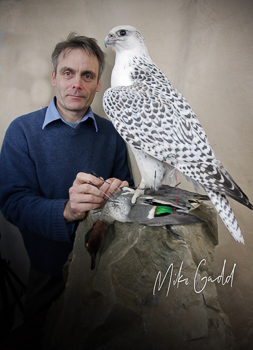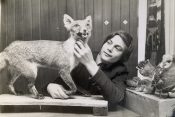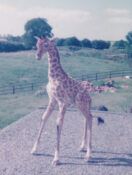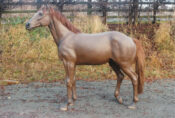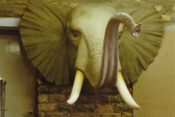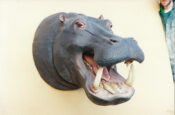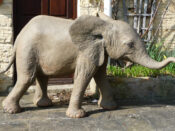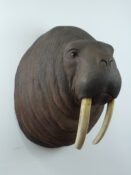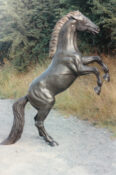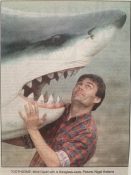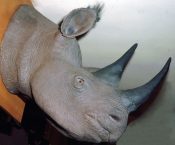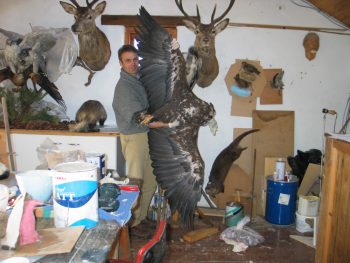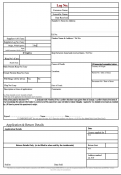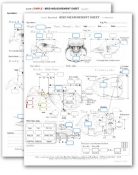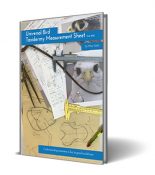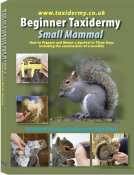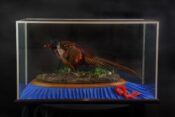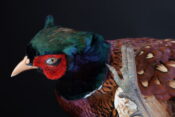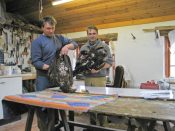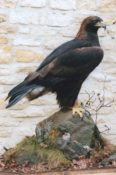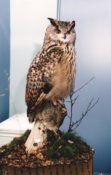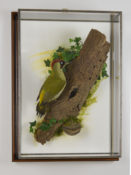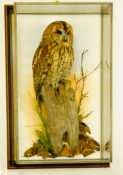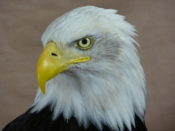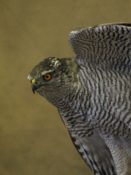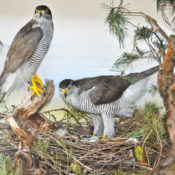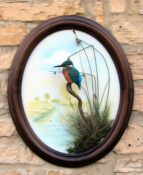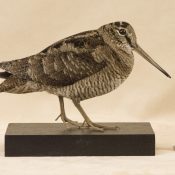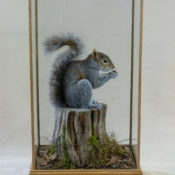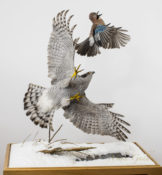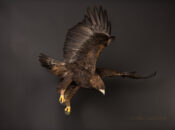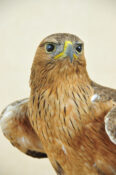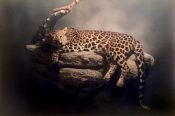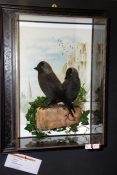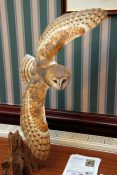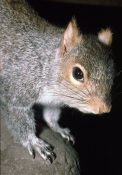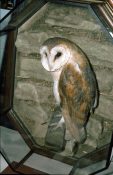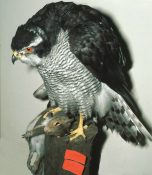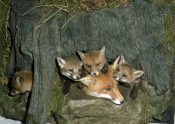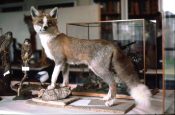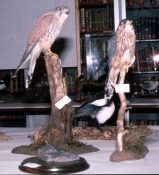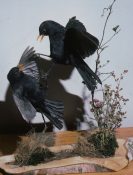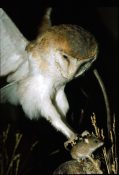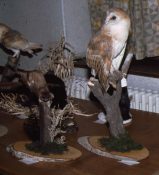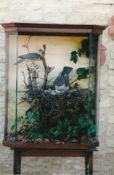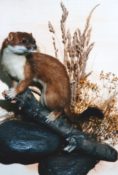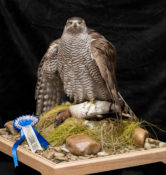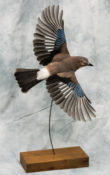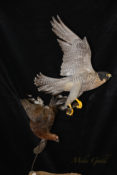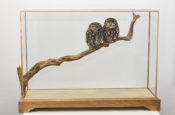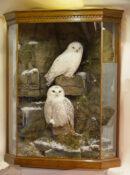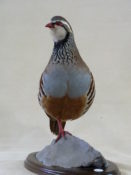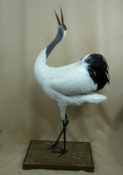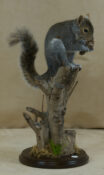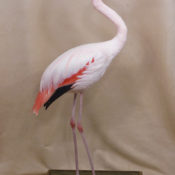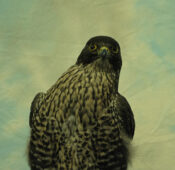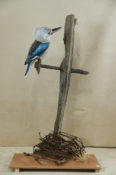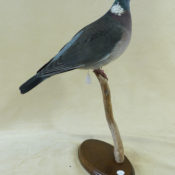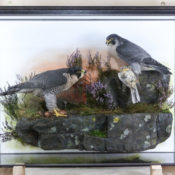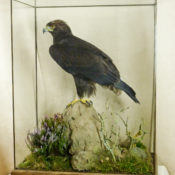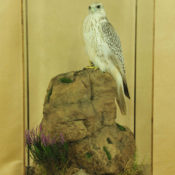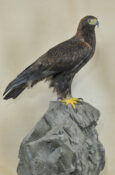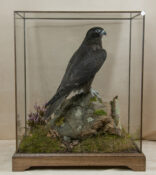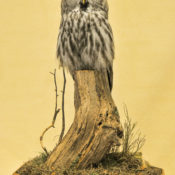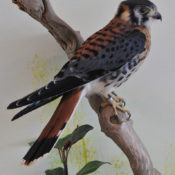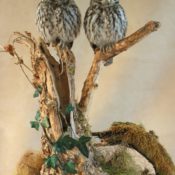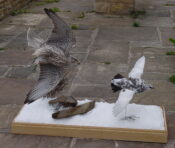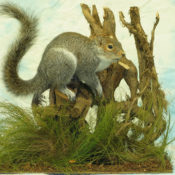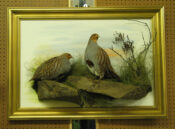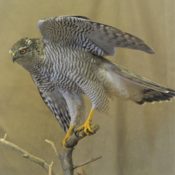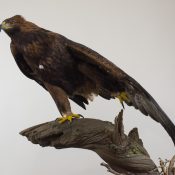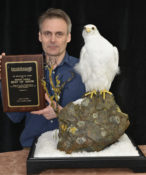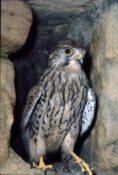MIKE GADD
What inspired you to take up taxidermy?
Like many people getting into taxidermy, I was fascinated by our amazing wildlife and kept all those things you would expect a young boy to collect, eg. beetles, eggshells, leaves, feathers and dead birds until they smelt and my mum made me throw them away.
On a visit to see my grandfather, I saw a stoat in a case by Watkins & Doncaster. I asked if it was 'real' and why it didn't smell, and he told me the story of how he had it preserved by a taxidermist. Whow!!! You can keep a dead animal and don't have to throw it away! the seed had been planted and just had to learn how to create this magic.
What was the first item you worked on and how old were you?
About 13, I did a house sparrow back in the day when there were lots of them :-(. I had a basic book from the library, equivalent to one A4. I used dried peas for eyes and the only way it stood up was a nail hammered through its body to a branch. I thought I was really clever hiding the nail under the wing as it didn't have any leg wires and the legs just dangled. It must have been truly awful and luckily I have no photos.
What was your first break into the industry?
There was a shop in Knaresborough called World of Nature run by Ed Milborough, an ex-circus and zoo owner. I would go there and see if I could get any help or advice. I remember Ed kindly allowing me into the secret workroom at the back of the shop, and he introduced me to Dave Astley, Tony Armistead and Peter Wallin who were working there. They were 'proper' taxidermists in white coats. I remember being in awe of them and the workshop. I asked about keeping a bird upright and was shown some 2 mm wire that they said they used for sparrows - they were so cruel. I kept trying and returning until eventually, Ed offered me a trial at £2.50 per week and I was so excited. My bus fare was about £2.00, but I was working as a taxidermist and will be eternally grateful to Ed. Of course, I got all the simple jobs like binding wool and sweeping floors. I remember spending most of my wages on a chip butty on Fridays.
Work/Career History
World of Nature moved to Kirby Fleetham North Yorkshire and Ed kindly asked me to join the team, so I moved with the business. However, it meant I had to leave home and school at aged 15, and pay for lodgings. Ed very kindly gave me a substantial raise to £12 per week to cover the costs. With lodgings at £6 per week, I had a significant amount to save. My career had started.
On my first morning, I was given two sulfur-crested cockatoos to mount I seem to remember I struggled to do one.
We got a lot of fallen stock from zoos and I was lucky enough to have worked on loads of big cats, three giraffes, cows, horses, sheep and fake creatures, mermaid, yeti, Unicorn, White Russian shore Muddler, and others. We even had a pet lion living in the house for a while, but he ended up in a cage after a few breakages and injury incidents, it was a little scary when he pinned me to the floor licking my throat, quite a few interesting stories wish we had modern cameras back in those days.
At the age of 21, I left World of Nature to start my own business, at first this was in my old bedroom in my mum's house in Collingham, then a workshop in Wetherby near the fire station in Wetherby. I had to move out and into a terrace house in the town.
A few years later, I purchased a house with two acres of grounds and built a workshop. I also started a casting and moulding business creating reproduction elephants, hippos, crocs, rhino, and a vast array of animals and figures for the leisure industry. At one point, I had 6 people working with me.
My Fibreglass Work:
However, after a few years, China realised the market in the UK and undercut us so hard that I gave up the reproduction/fibreglass side and just went back to working solo, sold the property and moved to Boston Spa.
Funny stories
Lots and lots "The live Lion and the Pekingese" "Lost cat" "talking elephant", "Customer trip" ....,
Tiger: When I worked in a small terrace house in town I had a phone call "Hi my tiger has died can I bring it around" yes of cause I said an hour later the doorbell rings and there on the pavement of the busy main road in the middle of the town was a man with his dead tiger at his feet, apparently the local vet needed to do some work on it, and wanted to tranquillize it first but missed its leg and hit its heart killing it. I had such good neighbours they just thought it was funny all the odd animals comming and going.
Notable Projects
Taxidermy - Early on, I did some giraffes for plant and machinery manufacturer and a leopard for a very famous rock star. I did very little for museums over the years and assumed they always wanted better taxidermists to work on projects. However, my last big project was about 40 sea birds for the National History Museum in London which I understand was only given to me due to time constraints. It was nice to work on albatrosses as I'd not done them before and always fancied doing one of these amazing birds; I ended up doing a few of them for the museum.
Casting and Moulding - I worked on so many systems. I was proudof the rhino head I made it was a one-piece silicone mould including ears and horns all in one. I believe it is still going after 35 years plus. This was a void cavity pore with many runners and risers, location locking points, etc, this took a bit of head-scratching to work out (no books or Youtube in those days) I also came up with a lamination system that allowed us to do something like the size of a horse head with less than a kilo of silicone rubber.
Specimen Log Sheet - I put a lot of effort into making this in 2000 as I wanted to have a standard way of recording items that came into a taxidermist's possession. I notice that DEFRA suggests this as a standard taxidermy log sheet, although I've updated it since. Previously, it was very ambiguous as to what was needed and legally, taxidermists were looked on with suspicion. I would like to think the universal log sheet helped.
Bird Measurement Sheet Standard and Simple - I found it very useful to have a good measurement sheet, so worked on it for years until I was happy that it covered all bird species from small to large and all the variations. In about 2016, I made this available to download for free for all to use.
Beginner Taxidermy Small Mammal Book -
My Publications:
Who inspired you the most when you were learning?
Tony Arminsted was my hero at World of Nature and Dave Astley gave me some great inspiration on techniques he had learnt from his time at Rowland Wards.
A few years later in 1981, after I started my own business, I heard of the Guild of Taxidermists that year there was a pheasant competition. I knocked out a pheasant ready to take and I was so cocky of my ability as I swaggered into the hall of mounts with my pheasant and looked down my nose at some of the poor mounts on display. I then saw the most amazing mounted bird I had ever seen immediately I wanted to put my bird in the nearest bin. The amazing pheasant was mounted by Derek Frampton and on that day, I realised it was possible to make a bird look lifelike instead of just stuffed. I felt well and truly put in my place and realise I was not worthy of putting my foot on the first rung of the taxidermy ladder. Seeing good work is so great and so inspirational.
Chatting with Derek, he mentioned Ian Hutchison had been a great inspiration to him and a few years later, the Guild was honoured with a talk from Ian about how he mounted a fish which was mesmerising and broke new ground in the way I approached my work. Ian's legendary talk on fish taxidermy was the single most helpedfull thing for my bird taxidermy more than any other.
When you talk to the great taxidermists, it is wonderful to see the connections of learning and a lot of it has been down to the great meetings of the Guild.
Who or what inspires you the most now or is it just Mother Nature?
Lately, Jack Fishwick has been a great inspiration the guild has on multiple occasions had Jack talk at conferences the depth of knowledge he has is outstanding. Jack also encouraged some of the worlds very best taxidermists to come over to the UK we were truly blessed with some amazing talks. Many a discussion with Jack and other top taxidermists around the world has come back to the same thing: observing the amazing workings of Mother Nature, in its amazing habitat, the secret is learning how to look.
Have you helped or taught any successful students?
I like to think I helped a few people improve their work.
A young Gary Tatterton knocked at the door when I had just started in Wetherby and asked if he could look at the animals. He ended up working with me for about 10 years before starting his own business and now specialises in producing some good head mounts.
There was also Carl Church who was a great attentive Guild member when I was doing 'Doctor's Surgeries. He was always first up and eager to learn, and boy did he learn, he later worked with me in Boston Spa for a couple of years. He has created a great portfolio of work anybody would be proud of and he is now progressing into sculpture. I am so impressed with how he and others have moved up, in a small way I like to think I may have helped.
I also started running beginner courses in about 1999 teaching around 300 pupils one of my star pupils would be David Irwin. David progressed really well and then returned for longer periods working together, I am very pleased and super impressed with his progress. Many of the others are now or have been members of the guild.
How have you seen taxidermy change?
Public attitudes are always changing. The Guild aimed to help change the public perception of taxidermy. When I started, taxidermy was very popular and now it seems to have changed to be more art-driven and taxidermy in schools and museums seems to have become frowned upon. There is a misconception that not having taxidermy will save the world, but in reality, about 1,500 species are going extinct each year. What we purchase, eat, how we travel make's a huge difference. reducing our impact and protecting the habitat of the world is the solution.
The opportunity for taxidermist has improved, the top taxidermists around the world are a lot more open with ideas and techniques. The rise of the internet has also been an absolute godsend to taxidermists for reference. I recently chatted with some friends and we discussed how it's not possible to accurately reproduce any item from the paintings in the old reference books that we studied back in the day. To become really good in taxidermy has never been so easy.
Guild Qualifications befor having to stand down
- Master Bird
- Specialist Bird
- Specialist Mammal
- Specialist Game Head
- Accredited Member
- Won the Bird Competition 9 times (never got that 10th win)
Committee Work
I joined the Guild in 1981 and was on the Committee for about 20 years. We used to physically meet in museums around the country which were great; you can't beat face to face meetings, but they got to be a drain on finances so we moved to conference calls.
Judging: I was a judge for many years. It's always awkward and I like to think I was fair and consistent. My mantra has always been to never mark something down unless I can say why and how to fix it. The most important thing I found was trying to give some time to the person who submitted the work with help and guidance on how to improve.
Lectures: I ran a Doctor's Surgery for many years at conferences where members were invited to bring in a piece of their work for critique and we discussed how it could be improved. A lot of people commented as to how it had helped them improve.
I called this method of giving critiques, the 'sandwich' ie. I would pick a problem that needed fixing and 'sandwich' it with positives. If I didn't know the person, I would first ask about them and if it's their first piece or if they've been struggling for a while; then start with positives about their piece before discussing the main problem (not all) that needed a fix and very importantly, how to fix it; then finish with another positive. If I cannot tell them how to fix a problem, I would KEEP QUIET. Hopefully, it would not be too upsetting but inspiring for the person getting the critique and they would find it helpful and be appreciative.
I also gave lots of lectures on mounting :
Birds: Mounting a blue tit carved manikin, Red Grouse buildup, Peregrine falcon carved manikin.
Mammals: Grey Squirrel buildup, Full Fox buildup, Sculpting and casting a roe deer head form in clay, and many others.
Photography: I remember talking to people after a conference about a piece, but there wouldn't be any photos. So I started to take photos of items that were taken to the conference and the Guild now has a good record (excluding my photographic ability) of work as can be seen on its conference web pages. I did all the specimen photography for around 10 years.
Website: I built the Guild's first website back in the days of flat HTML and old dial-up connection, progressing to a server-side include system with content design separation via CSS layout meeting W3 org standards which were state of the art at the time. I then built a Coldfusion site that worked very well but became expensive to update as the majority of the web went with PHP. The Guild employed a company to build a new database-driven membership system, but this quickly became dated and a bit of an embarrassment. I then instigated and populated a dedicated membership system website which took about 6 months to integrate the existing members and sort the problems. I then built a separate website for the historical part of the Guild with all-conference winners, meetings and history of the Guild. These sites have taken many hours and I have to give a big thank you to my partner, Lee, she has been of tremendous help as we worked on these over the years. The two systems should take the Guild forward for many years without the need to rebuild anything and they were my best shot at leaving a sound digital presence now I had to stand down.
Booking Form I made a complex form to allow members to register a specimen with the details going into a CSV file.
Membership secretary Part of setting up the new website involved sorting out the tangle of memberships some using different names, and going to different accounts, I and Lee spent over 6 months working our way through all the members checking payment addresses and details.
Treasurer This work was taken on by Lee who put her heart and soul into changing the accounts to allow online banking, backtracking all payments to members so we could better correct membership payments this took ages the new integration with the new website we set up should make the future running of the membership funds a lot easier.
Saddest Day of My Life The Guild to me has been like one big wonderful extended family. I have and always will consider all members to be friends loving the diversity of its membership, I have had some absolutely magical times, making some very special lifelong friends over the years. Toward the end of 2019, there was an upset over a Facebook post, I tried to mediate but failed to get the committee to accept mediation. My failure led to me having to stand down from the committee and all the Guild duties I so dearly loved. It was the worst period of my life and something that continues to haunt me and others daily. I live in hope one day the committee will support mediation.
Younger members were quick to fill the roles that I and many others who could not support the new policies left the committee and or the Guild at the same time created, there was luckily no great loss to the running of the Guild. I truly hope the new committee members can better shape the Committee and Guild where I failed. It has been and continues to be a great institution, and I highly recommend it to anybody in the taxidermy industry.
Being a committee member to me is like being a parent you should never take sides, always be fair, and love all equally. People will make mistakes, but the job of a committee member is to listen mediate, and help teach members to do and be better.
"A leader's job is not to take charge but to inspire and take care of those in their charge".
Other Interests
After I had to stand down from the Guild, my growing interest in environmental issues led me to become part of a local green group where we try to improve our area for wildlife and others, including a project to sample and enhance our river system to helping improve the water quality (this action achieved the UK's first bathing water status for a river), plant 1,000's of trees, lay hedges, oppose poor developments, reduce plastic waste, improve the local area for wildlife, teach others what and how they can help to take care of this amazing planet. I also ended up creating websites for green groups.
Learning about nature is a wonderful thing and I also enjoy photography which opens a whole new world.
Mike Gadd, 2020

